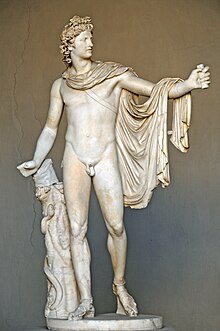
Classical sculpture (usually with a lower case "c") refers generally to sculpture from Ancient Greece and Ancient Rome, as well as the Hellenized and Romanized civilizations under their rule or influence, from about 500 BC to around 200 AD. It may also refer more precisely a period within Ancient Greek sculpture from around 500 BC to the onset of the Hellenistic style around 323 BC, in this case usually given a capital "C".[1] The term "classical" is also widely used for a stylistic tendency in later sculpture, not restricted to works in a Neoclassical or classical style.
The main subject of Ancient Greek sculpture from its earliest days was the human figure, usually male and nude (or nearly so). Apart from the heads of portrait sculptures, the bodies were highly idealized but achieved an unprecedented degree of naturalism. In addition to freestanding statues, the term classical sculpture incorporates relief work, such as the frieze and metopes of the Parthenon.
Although making large or monumental sculptures almost ceased in the Early Middle Ages and in Byzantine art, it greatly revived in the Italian Renaissance as Roman examples were excavated, and classical sculpture remained a great influence until at least the 19th century.
- ^ Cook, R.M., Greek Art, pp. 142, 148, Penguin, 1986 (reprint of 1972), ISBN 0140218661